
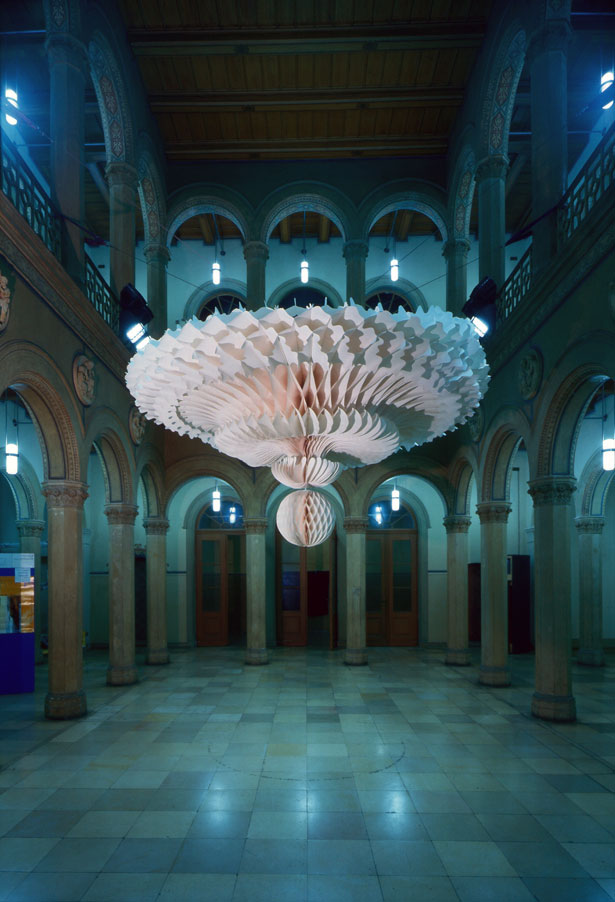


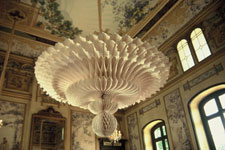
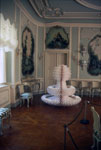
Lustgarten
Künstlerhaus Bethanien, Berlin
The exhibition Lustgarten was a series of large-scale ‘honey-comb’ paper
sculptures, produced during a one-year Australia Council Fellowship at the Künstlerhaus
Bethanien, Berlin, Germany.
In the late 90's I became fascinated by various types of collapsible forms -
objects that could magically transform from a flat shape into a 3-dimensional
form. This led me to study various systems of collapsibility, which eventually
led to 'honeycomb' paper decorations. In Berlin, I embarked upon a project that
involved the design and construction of a number of large-scale sculptural works
based on the 'honey-comb' principle (simply put - a system of alternating lines
of glue on many leaves of paper that once cut into a shape and pulled around
a 360 degree axis form a voluminous object). Through trial and error, I perfected
the technique and produced a mixture of freestanding and hanging objects that,
with careful positioning created a tension against one another.
Lustgarten was first shown at Künstlerhaus Bethanien, Berlin in 2000,
then subsequently at Schloss Pillinitz, Dresden (2000), Australian Centre for
Contemporary Art, Melbourne (2001), Artspace, Sydney (2001), and CAST, Hobart
(2002).
In subsequent years, several honey-comb paper sculptures were commissioned for the following: the stage production ‘Carmen Miranda Revue Pavillon’, Director - Holgar Freidrich, Haus der Berliner Festspiele, Berlin (2001); the concourse area of The Esplanade Arts Complex, Singapore (2003); a promotional event, Hermes Australia, Centennial Park, Sydney (2006); and the Moet & Chandon Spring Carnival Tent, Melbourne Cup (2006).
Photos: Jan Parker/Louise Paramor/David Brandt
Catalogue text by Dominic Eichler:
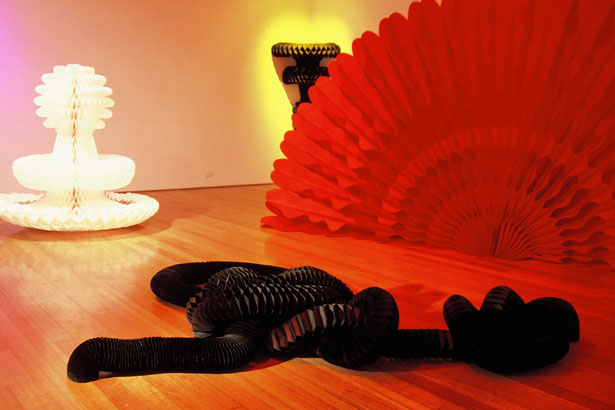
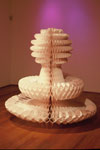
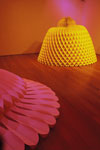
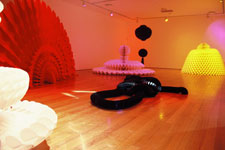

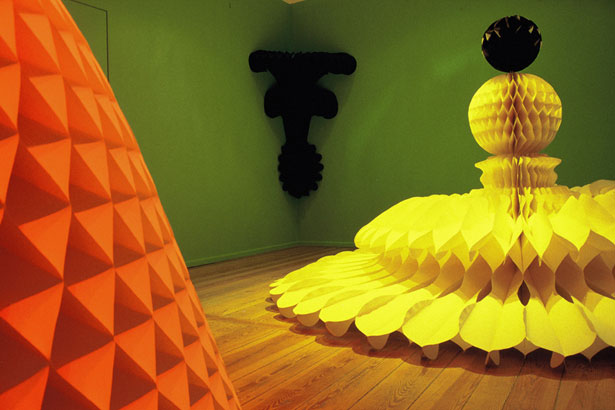
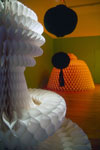
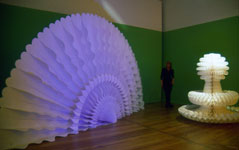

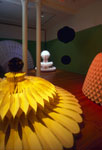
Fancy – the recent
sculptures of Louise Paramor
Dominic Eichler
“In his blue gardens men and girls came and went like moths among the whisperings
and the champagne and the stars … And on Mondays eight servants, including
an extra gardener, toiled all day… repairing the ravages of the night before
… at least once a fortnight a corps of caterers came down with several
hundred feet of canvas and enough coloured lights to make a Christmas tree
of Gatsby’s enormous garden.” F. Scott Fitzgerald, The Great Gatsby Balls
and other Festivities.
Social occasions divide up years, and all of them have their attendant
forms and rituals. The festive decorations which accompany many seem specifically
designed to remind you of every other similar occasion that you have ever
endured. They are imbued with an invitation to mentally wander down a potentially
tortuous nostalgic path. They dress a room – if only scantily, elevate
it out of the nasty humdrum, and give what goes on beneath them the status
of the ought-to-be memorable. Whether it is a bunch of hurriedly blown-up
balloons or ice sculptured swans in a rented marquee, the material principle
and the message is the same. To live for a special moment is to be surrounded
by light, fragile luminous things that have nothing to do with being built
to last.
The multifarious sculptures of Louise Paramor often appear to be celebrating
something (even if it is an occasion only known to themselves) or as if
they have been brought into being for a celebration. You could be forgiven
for happening upon them in a gallery or installed in a foyer and wondering
– is it all over or am I just too early? The sculptures for Lustgarten (2000)
– her exhibition at Künstlerhaus Bethanien, Berlin – evoke the playful
suggestion that the celebration (a garden party?) is alas only in someone’s
head.
Here is the moment in which bedfellows: excited anticipation and bitter
disappointment are indistinguishably bound together. It’s almost as if
the principally black clad art audiences are intentionally put in the position
of being gatecrashers, undesired guests at something to which they were
not really invited. You’re a distant friend of a friend of a friend.
In the 1990’s artists realised again that creating ambient rooms and party
atmospheres could be art. Paramor, however, has remained dedicated to the
production of sculpture. Over the last decade she has been increasingly
drawn to lightweight, comparatively inexpensive ubiquitous ephemeral materials
like paper, cellophane, wire, old glass, foil – an artist’s residency in
India cemented this predilection. She is clearly infatuated with valueless
stuff and transporting into the ultimate field of value judgments. And
to things that can be transformed by bright or clever light or by being
suitably situated. Hers are strange awkward works that often emerge only
at the last minute from a monotonous risky and laborious creation process.
The most recent sculptures with their illusion to decorations in both form
and material perhaps address our desire for physical permanence in art
and respond – that desire is a folly, everything is mutable.
Some Material Particulars.
The sculptures for Lustgarten are exaggerated, large white and black paper
decorations of obscure design origins – with an oriental touch here and
a “baroque” like curve and curl there. These bulbous waifs are the product
of the artist’s ferreting around for examples of a particular kind of decorative
technique – honeycomb paper. She then adapts and alters the design of the
machine cut miniature originals – her maquettes. For instance with one,
a bridal party silhouette which arched over everything was righty omitted.
She first applied the technique for a community arts project collaboration.
Later she perfected it for Lunarcake (1998) and Pink Fit (1998)
– a charmingly over-the-top hanging sculpture which evokes at once associations
with both decorative chinoiserie and geometric abstraction without, and
quite coquettishly, privileging either.
The new sculptures stand and hang as if conscious of their own eccentric
appearance in a field of green. The room is divided by a scallop edged
paper fan, that socially decisive and potentially divisive instrument,
especially when I the hands of a paramour. It is scaled so that it can
not only shield the face from unwanted admirers but rather your whole costumed
body. Elsewhere two jet black quince shaped pompoms hang like planets
in a fixed orbit. Everywhere intriguing delicate forms like millefeuille
pastries, constructed of at least a hundred glued layers of paper, open
in the room like alien blooms. This sculptural scene, an artificial garden
of sorts, is lit by jel covered spots. It is a pretty and shamelessly theatrical
sculptural situation, which employs the traits that Michael Fried described
in his objection to some minimal art of the time for being ‘theatrical’.
The works have presence and operate like a confrontation with a silent
person over a period of time. The inflection that Fried then gave the word
“theatrical” by attaching the verbs “corrupted and perverted” reminds me
somewhat of much earlier modernist attacks on ornament, embellishment and
decoration. Louise Paramor’s new sculptures are, apart from being theatrical,
also literally and unabashedly decorative. It comes as no surprise that
reception of her first solo show with this kind of work at William Mora
Galleries, Melbourne – 1964 (1996) – met with the banal objection
– but this is just decoration. Such an objection has a modernist history
– ornament and decoration being seen as antithetical to good form, a kind
of masquerade, or like an over-dressed woman. Seen in this light, Paramor’s
sculptural synthesis of florid and floral forms, colour lit white surfaces
and sensuality are a form of feministic retort to an ingrained prejudice.
World Without End
The foyer of Bethanien is a neo-romanesque column and arch affair with
semi-restored paintwork. Here Paramor hung a broad white expanse of honeycomb
paper that recalls a chandelier. There is gentle irony that the work suggests
something much more festive than the surrounding rather morbid interior
– ghosts and all – of one of Berlin’s first modern hospitals (circa 1845)
which is now a visual arts and cultural centre. In 1997 for a group exhibition World
Without End in St Patrick’s Cathedral Melbourne the artist installed
a sparkling concertina or fold-out chandelier made from heavy gauge aluminium
foil.
The exhibition first conceived of by Jock Clutterbuck was then carried
out by Rosemary Crumlin RSM (included here in order to give credit where
credit is due, but also for the ring of the names). The latter is a catholic
nun who was concerned to enquire: is the divorce between church and art
final? Chandelier (1997) was also shown as part of primavera (1998)
in the foyer of Sydney’s museum of Contemporary Art. Both works are like
garden follies, eye-catching incidents, formal occasions but rather at
odds – in a demonstratively flirtatious way – with their institutional
settings, whether cathedral, museum, hospital or visual art venue.
The Lustgarten
The Lustgarten – a pleasure garden, an attractive garden designed for conversation
and strolling – predates the European invasion of the artist’s birthplace,
Australia. There the Lustgarten’s distant relative, the public park, developed
principally in accordance with English developments as the pressures of
the industrial revolution and teeming urban centres necessitated that designated
green areas be opened for the general populace. It is a particular feature
of the Australian situation as a colony that the transplanting of social
norms, laws, architecture, art etc. resulted in bizarre clashes and incongruities
(not to mention genocide).
In a way the aesthetic history of Australia, the wealthy colony – is the
story of crazed and ambitious importing of cultural products (in return
for primary resources), opening the crates and then dealing with the resultant
mess. Paramor’s works are full of such style clashes and an approach to
materials and referential sources which has aspects of the Australian condition.
Although her works form definite quirky wholes, they appear far from self-evident
or self-contained. They are nearly always large ungainly or flimsy unlikely
things for example: Phantom Valley (1997) - a red cellophane mountain
with blue buds on it or Bala (1996) – paper drums srung like beads
on a necklace hanging on a wall, or Big Mouth (1993) – a kind
of gaping floor mirror that has opportunity shop glasses for teeth. The
new sculpture too has the same quality of estrangement from a variety of
cultural sources, source which have under gone a process of displacement
and hybridisation. Semi-detached, temporarily detained, self-supporting
and capable of collapsing.
Lustgarten was reviewed in the following newspapers:
Der Tagesspiegel; Dresdener Neueste Nachrichten; and The Australian.
It was covered on ZDF (German National TV), ‘Hot Spot Berlin-Künstler
aus aller Welt an der Spree’, and ‘The Arts Show’, Artist
profile, ABC TV (Australian National TV).
Lustgarten (Schloss Pillinitz, Dresden) was featured on the
cover of Art&Australia magazine, with an article by Eve Sullivan
‘The Love Artist’ (September 2002).
Two pieces ofLustgarten (black hanging form and red fan form)
are owned by The National Gallery of Victoria.